October 26, 2018 by Nina Horowitz in News with 0 comments
On Friday night during the 2018 National Championships, USA Ultimate hosted a dinner combining the last several years of Ultimate Hall of Fame inductions and a celebration of the 50th anniversary of ultimate’s founding. In a room filled with more historic star power than possibly any other gathering of ultimate players ever, people discussed how the sport has changed over time, what they would like to see USA Ultimate doing for the future of the community, and – of course – which city has the greatest ultimate legacy.
The Hall of Fame inductees this year included leaders and pioneering athletes like Tiina Booth, Skip Kuhn, Dominique Fontenette, Stu Downs, and Amy Wilbur as well as the group of ultimate players known as the Johnny Appleseeds – the original Columbia High School students who played the first recorded game of ultimate in 1968 and spread it to the world when they graduated. Considered the founders of ultimate, they shared the ceremony with former leaders of the Ultimate Players Association, USA Ultimate CEO Tom Crawford, and World Flying Disc Association President Robert “Nob” Rauch, as well as members of every storied team from New York New York to the Lady Condors. And let me tell you, they had a lot to talk about. The ceremonies took several hours and offered everything from standard speeches to an old-school video on the sport’s history to a “we are family” sing-along and, of course, a call to action and an emphasis on the importance of getting ultimate into the Olympics.
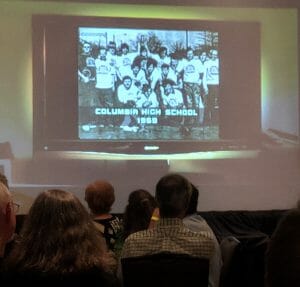
The atmosphere of the dinner felt historic but not stuffy – the hundreds of attendees talked loudly during many of the attempted announcements, dressed in a huge range of formal attire, gave at least ten standing ovations, and drank heavily throughout. UltiPhotos staff attempted to wrangle everyone for class pictures as their friends heckled them while teammates reunited and shouted their old cheers. Old friends laughed over stacks of film photos, people told stories of how they met their significant others at ultimate tournaments in the 1980s or 1990s, and many yelled “travel!” at some of the plays included in the highlight reel. Every single person was clearly overjoyed to be in attendance, and USA Ultimate did an excellent job of balancing the natural goofiness of ultimate players with the intended seriousness of the occasion.
Dinner began with an opening speech by Rauch, followed by a champagne toast sponsored by USA Ultimate and a speech from Wham-O’s former head of sports marketing. Next up was a video about the Hall of Fame inductees, a review of USA Ultimate’s strategic plan, and a brief introduction to the charities that USA Ultimate sponsors. In between each of these, a new class of awardees were officially and rapidly inducted so as not to lose the attention of the audience.

During one of the speeches, it was announced that ultimate is hoping to build a physical Hall of Fame in New Jersey within the next few years. There is currently a search committee looking for the specific location, but much of the material has been collected and is ready to be displayed. USA Ultimate also announced that they were donating a $10,000 grant to Ultimate Impact, an organization dedicated to improving the lives of children in underserved communities through mentorship and the sport of ultimate. After inducting the final class of Hall of Famers, Phil Adams discussed the activities that would be held over the following days and Rauch gave some closing remarks. Then everyone stayed and drank for another three hours.
For those on the East Coast who couldn’t join in for these festivities, there will be an Ultimate50 event in Maplewood, NJ from November 22 to 24 of this year to celebrate the birthplace of ultimate.
I spoke with several members of the old guard to get their opinions about the direction ultimate is moving, the ways the sport itself has changed, and what they love about the ultimate community. Here are a few of their thoughts on ultimate in 2018, edited for clarity, and with the disclaimer that many of these people had not watched a tournament in years – let alone ever played in a horizontal stack or a game to 15 points. One person asked me what city Revolver represents, another was surprised to hear that the AUDL actually had referees, and many couldn’t name a single active women’s team except for Riot.
How the Sport has Changed
Bex Forth, founder of the EuroStars tour and elite competitor at the international level for more than two decades, pointed out the massive differences in tournament coverage between her early years and today. “UltiPhotos used to be just photographers who would print out their photos and put them up on boards at tournament central for the players to look through and potentially purchase,” she said. When I asked her if she ever bought any, she laughed and said no – she was poor!1
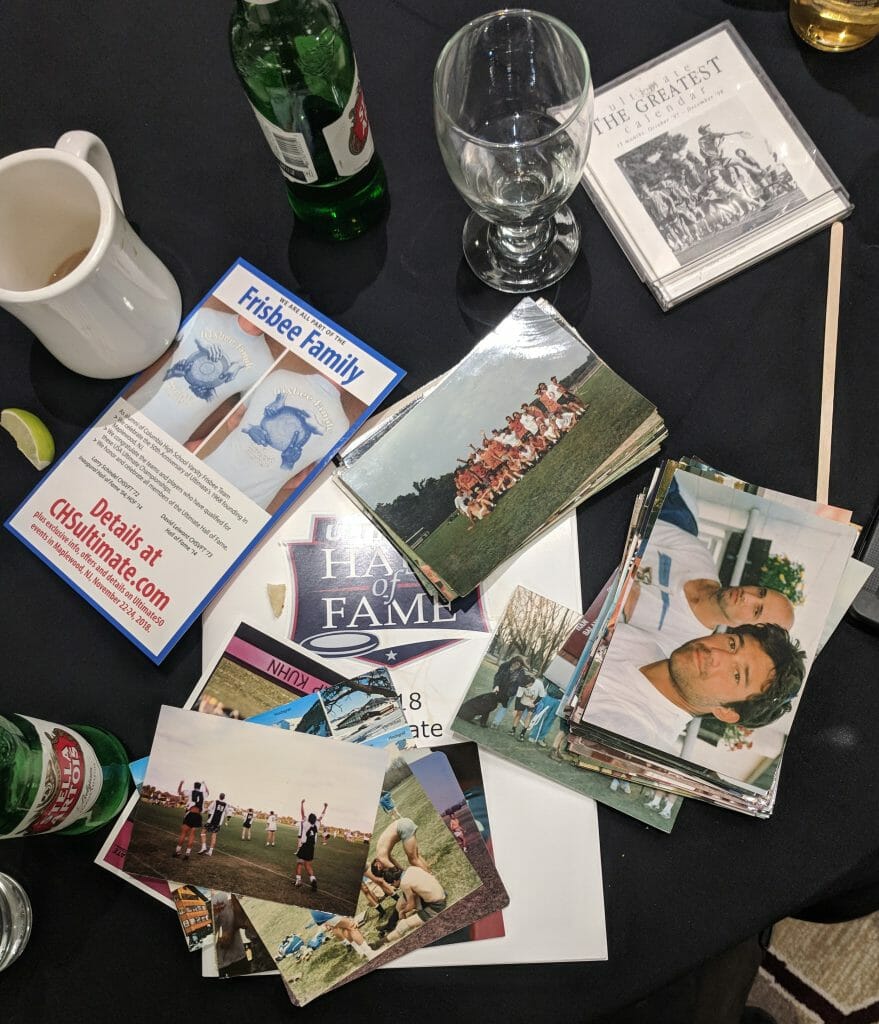
Hall of Famer and ultimate legend Steve Mooney said “the biggest change in the game has been the speed of the players and the skill across the whole team. Strategically it has advanced some, but the athleticism is more than before.” This was echoed by his fellow Hall of Famer Skip Kuhn, who said, “I find the athleticism of the sport is just unbelievably off the charts but I’m disappointed in how conservative the play is. I wish people took more risks and played more hockey style or something like that. I wish it was more aggressive – it seems a little reserved.”
He added, “There’s a cap on how many players a team can have and it’s 27. That’s one person shy of four full lines! So that’s a lot of players on one team. If you want to make ultimate a little different, maybe a good regulation would be to limit the number of players per team.”
It didn’t take long for me to hear the exact opposite perspective. Three of the athletes who used to compete with Women on the Verge told me they thought the game was much too short nowadays. “There are a lot more people just throwing it away!” they lamented. “There was a lot more valuing of the disc before when we had a lot more points. You played to 21 back in the day and there was no time cap, you just kept going… Now it’s just kind of bomb it down the field and hope for the best, and that’s not how we used to play. I see that in both divisions.”
Overall, this was the biggest talking point people discussed with me. Everyone thought the game looked different, but no two people fully agreed on the specific ways it had changed. I heard that people used to be more physical and that they used to be less physical. People take too many risks and people play far too conservatively. Poaching makes the game boring and that poaching was the inevitable evolution of defensive strategy.
The one thing everyone agreed upon was that the level of athleticism had definitely increased, and that was a good thing.
On the Future of the Community
WFDF President Nob Rauch said that “the key for the future is basically to broaden the base. We’re doing some amazing things with gender equity, but we don’t yet have a diverse group. And the way to get there is to grow the youth. If we get into schools, all of a sudden you are going into places where you don’t have natural bases today. And that’s really going to be key to the future of the sport.”
To Rauch and others, the Olympics are a big part of this goal. “If we can get Olympic recognition, we’re going to get the credibility and legitimacy to be able to move forward and attract an entirely new group of people,” he predicted. “Sport climbing got in for the 2020 Olympics in Japan and they had 30,000 new people trying it in the last year alone. I think that’s the benefit of aspiring for the Olympics.”
Another big goal for Rauch is the development of a physical Hall of Fame near the birthplace of ultimate in New Jersey where people can go to look at ultimate artifacts and read about the history of the sport and previously inducted players. “We started this in 2004 and it’s still a virtual hall,” he said. “We’re going to make the transition to a standalone governed sport with a physical hall of fame. If you look at the exhibitions here, it’s just incredible the amount of stuff that has been gathered and is basically sitting in boxes. There’s so much more that can be done, and we can see the indication of the other types of exhibits we could have.” As for when this Hall of Fame might actually open, he said, “If we can excite the local Maplewood group out of Columbia High School, many of whom are still living in the area, to really help us spearhead that with a little bit of direction – and if we can get a lot of financial support from the ultimate community – we should be able to get that going within the next five years.”
Unfortunately, with growth comes great responsibility. Kuhn says ultimate players are “driven people who work pretty hard, and that’s what I like about us. But how do we balance our uniqueness with wanting to be mainstream?” he wondered. A big part of this is Spirit of the Game, which (unsurprisingly) very few people agreed upon.
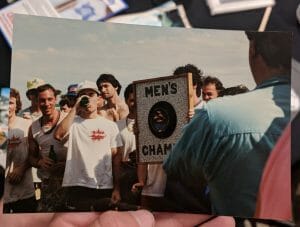
On Spirit of the Game and Observing
“I watched some games, and I was disappointed in the observing,” said one former athlete. “I thought the observers had too big of an impact on the game and the players had no opportunity at all to adjust to each other’s intensity, which was sad because it stopped the flow of the game.” A New York New York player concurred, adding, “The game is less physical but with just as much stopping as it used to have. Maybe I’m biased, but it seems like it used to be way more physical but people tolerated the physicality. You decided how physical you wanted it to be. Some people were touchy feely, some people weren’t. You could be more physical with some players.”
I asked him if he thought that level of physicality meant players were unspirited, and he said that wasn’t the case. “I was a player who welcomed that intensity,” he said. “If you were going to be intense with me then that was a motivating factor for me to be intense back. So I enjoyed the physicality, it pushed me to play harder. Other people didn’t. But players should be able to work that out and I don’t like the observers…Let the players figure out where that boundary is.” I asked him if he had seen a single time where the observers were useful, perhaps for rule clarifications, and he answered with an unequivocal no.
Does this development of the observing system stem from poor spirit or just a necessary change as the level of athleticism increases?
Ed Summers, one of the Johnny Appleseeds inducted into the Hall of Fame this year, commented on the evolution of ultimate. “From the point when ultimate evolved into club play, that’s when intense competition started,” he said. “And I think Spirit of the Game took a hit in that period. But I take heart from the fact that during that period when people were saying spirit was dead, and they were spitting in your face and showing other unsportsmanlike behavior, some people looked past that. I see now that those people who were playing with good sportsmanship are some of the best contributors for the future of ultimate now. Developing things like Ultimate Peace, broadening out where ultimate can go, being in charge of WFDF, etc.”
It is a true testament to the complexity of the concept of SOTG within the context of elite sports that two people can have such opposing ideas of whether or not spirit was alive and well in the early club years. “I think that kind of regeneration is probably something we’re going to have to go through again,” said Summers. “We are going to go through periods of growth and reintegration, but it’s going to take work for all of us to keep that Spirit of the Game and that unique character that ultimate has to make it not just another sport.”
Some people told me they thought spirit is better off now than it ever was before, especially in younger players. Kathleen Histon, who coaches middle school ultimate, said, “In Seattle and the Pacific Northwest, we have amazing youth ultimate and the emphasis on Spirit of the Game is great. It’s going in a very positive direction…There was always ‘the Spirit of the Game’ but it was just kind of there, and now it’s institutionalized. Every practice we have, at the end of the practice, we pull it in and have a spirit circle. At first I thought it was kind of hokey because I played at such a high level that we didn’t do that as often, but now I feel like it’s amazing. It’s something I think was always there but was missing as a central aspect of the sport.”
Summers also acknowledged the importance of this transition from a nebulous concept to an actual rule, explaining that now that “the spirit of the game has been codified – there’s a clear definition of what it is as opposed to having to evolve from the general idea of sportsmanship. I think that ultimate frisbee is going to go through multiple evolutions. The first one was when I was in high school, and we got the rules, and we had to start evolving something that would work with different teams playing each other instead of just one school. From that point, we went on to the college level where we had to start again teaching more people about what Spirit of the Game was and developing spirit cheers and a sense of community across schools for other ultimate players. From there, we went to a player’s association and we as an organization of a group of players kept control of the rules. That was vital in not having to commercialize and to keep having the elements that make ultimate unique and something special for the players and the community. Without that, it would have probably gone the way of other sports.”
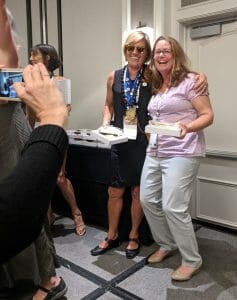
So how does the development of the AUDL and other professional leagues affect this player-controlled aspect of ultimate? Hall of Famer and CHS founder Sholom Simon wasn’t sure. “I admire the experimentation, that’s fine, but my biggest concern with them is about who’s in control of the sport – whether it’s corporate, organizational, or on the field,” he said. “For the future of ultimate, what we need is to keep what’s special about ultimate. We don’t need to emulate other sports. I fear what could happen if we get too far into pro leagues, or how we look on TV, or if we get into the Olympics. It’s very self-validating, of course, but we don’t need to be like other sports because those other sports are already there. Let folks play those other sports! We need to make sure that what’s very special about ultimate remains an essential core part of ultimate. I don’t think the AUDL is doing that, or thinking about it in those terms. I don’t know who’s really driving that train or what the bottom line motivations are. And, of course, in my view, when you have referees on the field that can stop play and call a foul, then we lose one of those essential core aspects of ultimate – it becomes just another sport.”
Last but not least, it wouldn’t be a conversation with people from a previous generation without some unsolicited life advice. So I’ll pass that on to you.
Chris Williams believes that the key to success and longevity is “don’t run very hard! Don’t try to be fast and get open all the time, and most importantly don’t play defense. Poach all the time! You can totally get a turn that way. Intelligence trumps athleticism constantly.” The alumni of Women on the Verge say to “love your team! We had four people from Women on the Verge inducted this year, and we had 28 people come to the ceremony because that’s how strong our team was. Our team was incredibly tight and that’s what made us amazing.”
One of the speeches on Friday included a moment of silence to remember all of the early ultimate players who were no longer with us in 2018. The speaker was Dan “Stork” Roddick, who is considered the first person to explicitly frame Spirit of the Game as a key aspect of ultimate. He reminded the audience to please enjoy each and every moment we are out on an ultimate field because they are all truly special and you never know which one will be your last. The real meaning of Spirit of the Game, he explained, is appreciating your team, your opponents, and the sport for what they represent – a brief flash of magic that can only be experienced when you are truly in the moment and loving everyone and everything around you.
***
It’s clear that everyone comes to ultimate with a different background and wants something different from the sport. These arguments and disagreements are now half a century old but fundamentally unchanged, and there will never be easy answers. USA Ultimate is doing the best they can to appease an incredibly diverse group of people and grow the sport at all levels, and there is no outcome in which every single person will be happy. But to most people who were present at the ceremony, the sport is moving in a positive direction.
I will end with an excerpt from the Hall of Fame program that was handed out to attendees. Compiled by David Blau2 it included short speeches by all of the inductees about what the sport means to them and the ways it has changed their lives. Amy Wilbur, a leader of the early New York women’s ultimate community, two-time Nationals winner with Godiva, and MVP of the 1990 World Champion Lady Condors, wrote:
Thanks to my father, who taught me how to throw a frisbee, and, in 1980, to ending up in the ‘WUFO Central’ dorm at Williams College, I found Ultimate.
Almost 40 years later, I am grateful to have the chance to formally thank the many bright minds and industrious souls that have had the vision and energy to take the game from its gritty origins to the exciting sport it is today. Along the way it has swept up both my sons, and I am thankful for that too.
I came of age at a moment when women’s team sports were in their infancy. When I began playing ultimate very few of my teammates had ever been on a team prior to stepping on the ultimate field. But we were all in – seduced by an amazingly fun sport and attracted to the community of young women and men that evolved around it. We lived and breathed ultimate, practicing on glass-studded fields in New York’s Central Park and throwing a disc anywhere and everywhere. We learned how to be fiercely competitive when our upbringings told us to ‘be nice.’ We danced on the sidelines with our opponents, spilled our guts to one another on interminable car rides, did mountains of muddy laundry and left it all on the field.
At that time, we were a small community of women players, with enormous spirit and great respect for one another. Over the years that community has grown tremendously but so has the spirit. The magic of ultimate continues to bewitch. I was blessed to fall under its spell, and I would do it all again in a heartbeat.
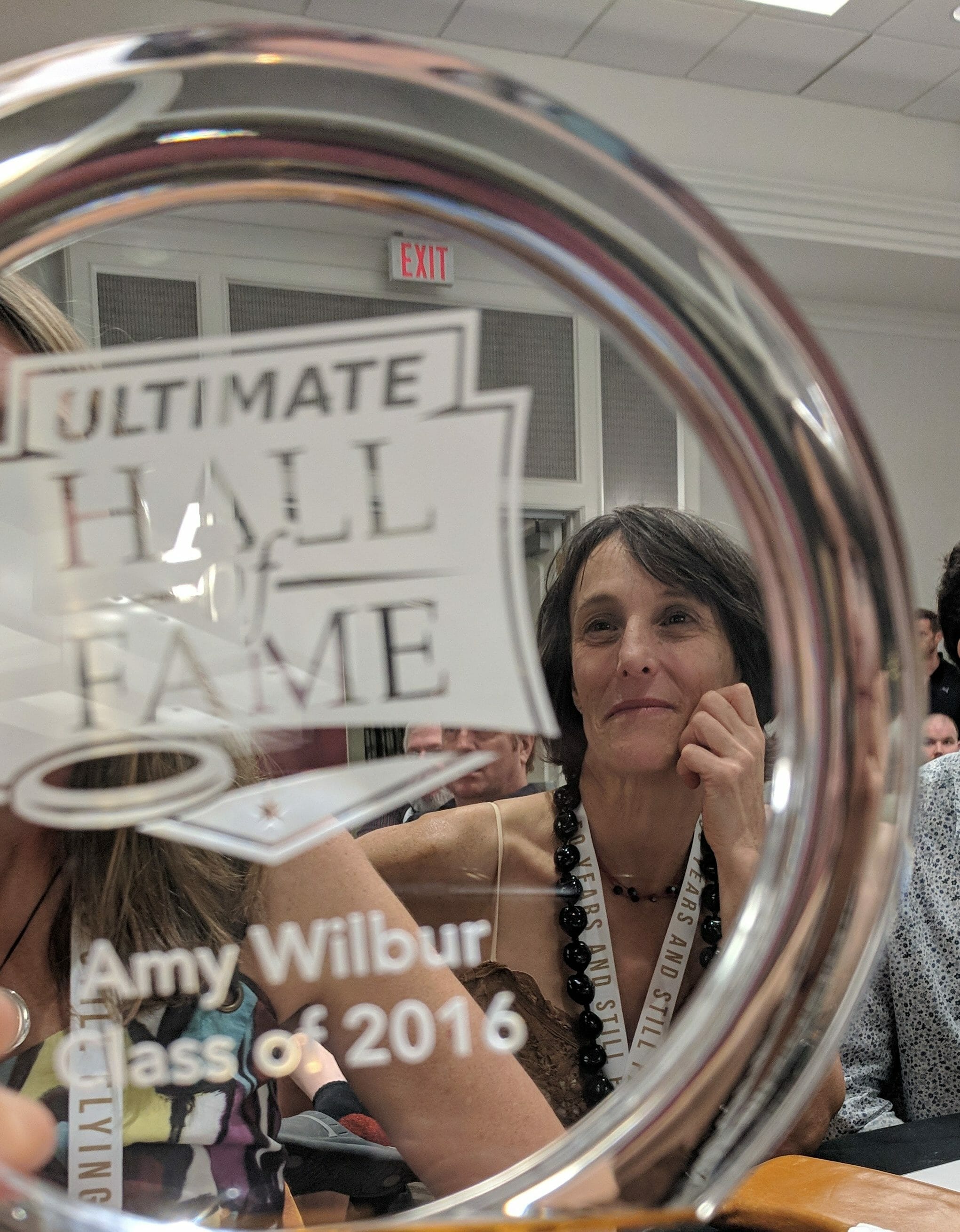
Editor’s Note: Buy your photos from UltiPhotos! ↩
Correction: An earlier version of this article incorrectly credited Emmett Blau, David’s son, with compiling the speeches ↩